Gina wrote to ask about planting a high desert food forest:
“I would like to know however how to create a food forest in the high desert of New Mexico. We get very little rain and what we do get comes in torrents. Our temps do go below 0 during the winter and in the summer we reach 100+.
Our soil is dry sand or clay. We also have annoying little pocket moles and rabbits that like to munch on almost anything we plant. Here’s a couple pictures.
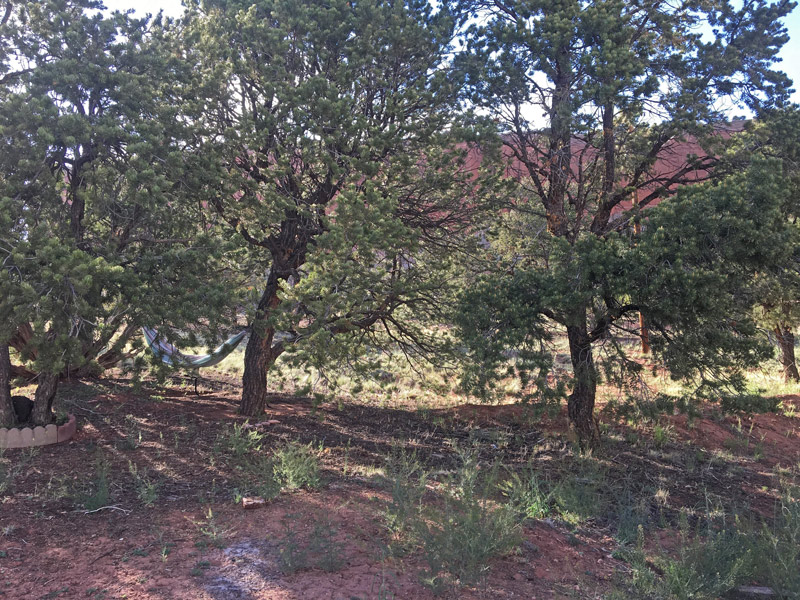
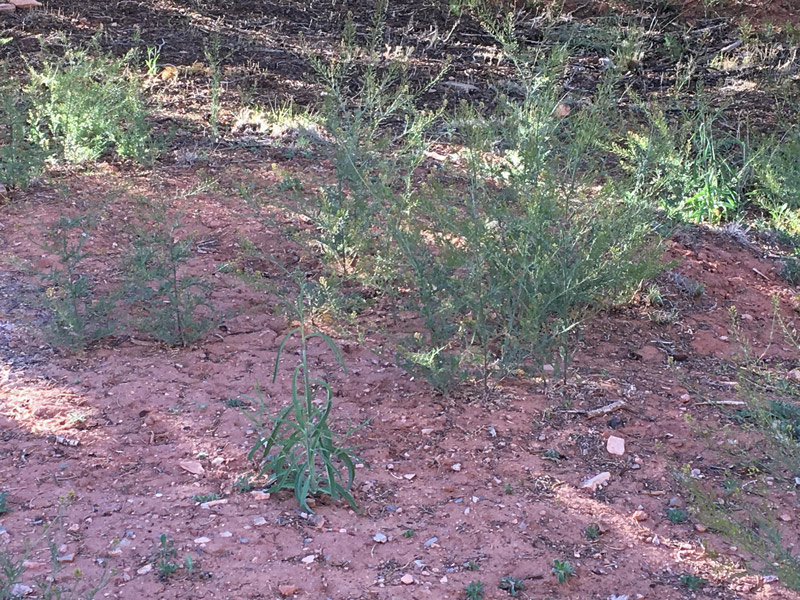
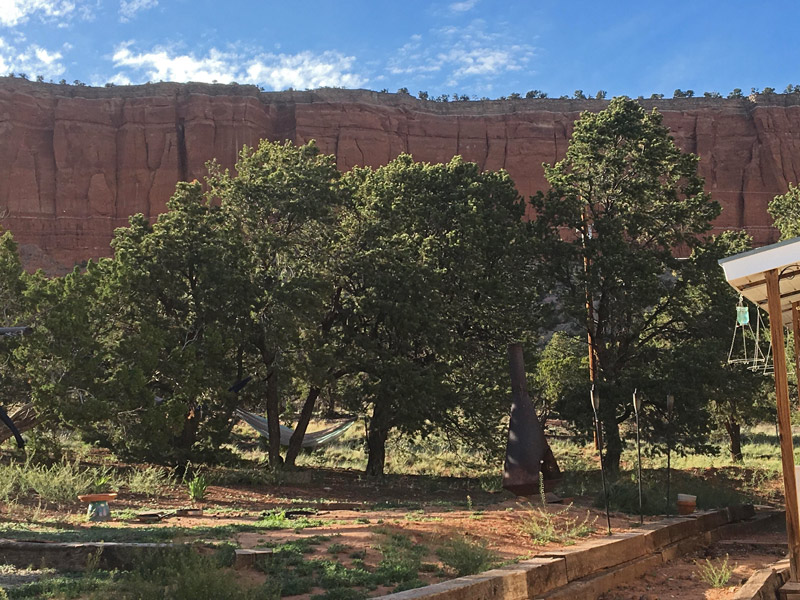
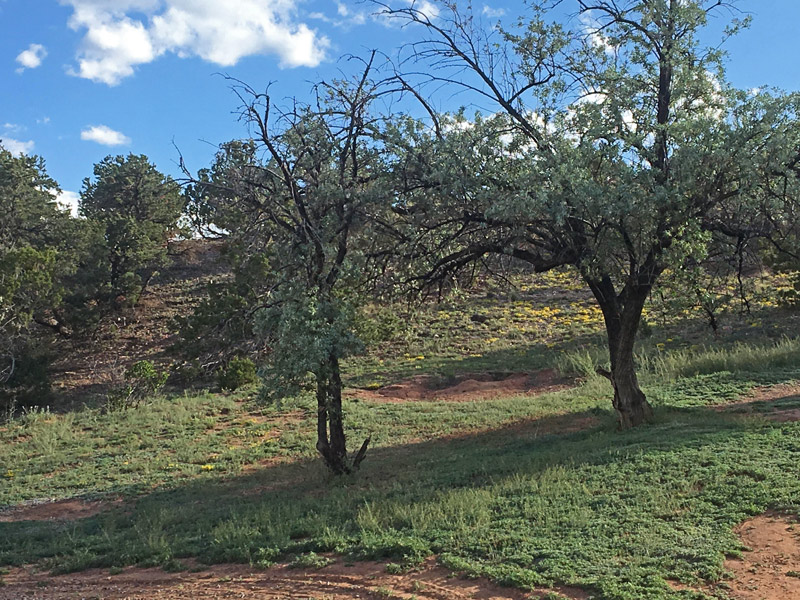
It looks very green at the moment. We’ve had a lot of rain this past week-more than normal for this time of year. The green is mostly weeds which wither and blow away when the heat starts increasing.
We’ve tried several times to just grow grass to help decrease erosion, etc but it doesn’t seem to like the soil.
If you could point us to reliable resources or have any ideas we’d greatly appreciate them! We’re at 7,500 elevation.
Thank you!
Sincerely,
Gina”
Before I write anything else, I have to post a disclaimer. I am no expert on desert gardening. I also got violently ill the time my Dad took me up Pike’s Peak. This is why I researched and interviewed other people for this article. There’s nothing like on-the-ground knowledge.
That said, there are some permaculture fundamentals that will immediately help this difficult site.
Harvest all the Rainwater You Can!
Water is life. Gina writes: “We get very little rain and what we do get comes in torrents.”
When you get torrents, it tends to just run off, taking your valuable topsoil with it. That rain needs to be help on the property as long as possible. I highly recommend finding the slope and digging swales to keep the water and help it soak into the ground. It will make a world of difference.
Here’s a small high desert swale system in action:
You can see a more impressive swale system here:
Get water saved first. Swales are the easiest way to hold it on your land. If you are more ambitious, ponds are also excellent, even if they are just seasonal.
Build the Soil with Plant Cover
Once the water is being held, establishing plants becomes easier. Volunteers will pop up in the bottom of the swales and they’ll also start to hold the organic matter that has been blowing away.
Support plants which build the soil should be your main planting goal. Nitrogen fixers, erosion stoppers, grasses, windbreaks, biomass producers – these will improve the ground so your fruit trees will prosper.
The New Mexican Locust might be a good choice. In this tree guide I found, it is described thus:
“Spiny shrub or small tree that often forms thickets. The bark is slightly gray with furrowed scaly ridges. Showy flowers appear in spring and early summer in large, drooping clusters. The fruits are brown bean-like pods with bristles. It is among the first woody plants to grow after wildfires but is soon shaded out by taller trees. Like many members of the pea family, New Mexico Locust has a symbiotic relationship with nitrogen-fixing bacteria that live in nodules in the plant’s roots.”
You might also plant some quaking aspens, as they look like they’d thrive and create some biomass for you. You might be able to coppice or pollard them for repeated chop-and-drop.
I called the USDA to get some help on grass varieties for your area, and spoke with soil conservationist Martin Meairs. His focus is on pasture, and he shared that a lot of the problems with erosion issues in your area are due to years of overgrazing. They have also had problems establishing grass, and he noted that Tractor Supply has been known to sell “native” seed mixes which are not really native to the area and need too much water to establish and maintain.
For an erosion stopping grass, he recommended planting sand dropseed, AKA Sporobolus cryptandrus. For a better forage grass, he also recommended blue grama grass, which is “common, tough, and drought-tolerant.”
Martin also recommends good fences if you are near grazing land, as cattle can make short work of your gardening plans.
First you want to stop organic matter from washing or blowing away, then you want to add more and more to the soil. Swales first, then support species, then it’s time for edible trees.
Trees for a New Mexico High Desert Food Forest
If you don’t have pines with edible pine nuts, I would add those, as some species are likely to do well at your elevation.
There are also edible native species, such as chokecherry. As Gail Haggard writes:
“The indigenous people flavored foods with spruce buds and juniper berries, and they ground and cooked the seeds of saltbush and Indian ricegrass, which was a major sustainer. They ate the cactus pods and the flowers of Yucca after boiling and roasting. All summer they ate the leaves and flowers of fireweed and bee balm, also called oregano de la sierra – more delicious than commercial oregano. They ate wild plums and rosehips and berries of chokecherry and wax and golden currant and three-leaf sumac, also called lemonade berry. The nuts of pinon, ponderosa and white pine are nutritious. Naturally many, many wild seeds and nuts, roots and bulbs, dried fruits and meats and mushrooms were stored for the winter.”
Obviously, some of those species won’t be in your dry and arid elevation; however, there are probably good options there as well. If you can find a local food forager who covers that area and take a tour, you’re likely to find out more.
I like to start with the native edibles and then move on to their cousins and then on to other plants from around the world that grow in similar climates. If you start with the really easy stuff, it’s encouraging and you can build from there – though you’re almost certainly going to want improved fruit trees as well.
To find out the best fruit trees for your area, I spoke with Donnie Pigford at San Juan Nurseries in Farmington. He was a wealth of information and is quite enthusiastic about the many varieties of good fruit you can grow in the New Mexico’s unique climate. Donnie is a third generation nurseryman, having taken over the nursery started by his grandfather in 1951. He’s also working on the establishment of a botanical garden in Farmington, and has introduced many locals to the value of bees and beekeeping through the hives he keeps at the nursery.
When you don’t know what fruit trees to grow, it’s always best to call a local nursery owner.
“With cool winters, we can grow many different varieties of peaches, nectarines, apricots,” Donnie shared. “This year, with the high snow pack and a good spring, we are having a bumper crop of fruits. (The nursery carries) 10-15 different varieties of those. Plums do well, apples do well, so do cherries, almond and black walnut. Pecans will thrive but the season isn’t always long enough for production. You can also do great with pears, Asian pears and service berry, which is beautiful tree, plus it produces a great edible berry. As for berries, you can do raspberries, blackberries, gooseberries, boysenberries, goji berries – and there are even native varieties of goji berry.”
Final Thoughts on Establishing a High Desert Food Forest
Again, though, whether those plants will thrive is really dependent on soil and water.
“She is probably dealing with extremely high pH,” Donnie said, when I asked him about Gina’s soil conditions. “It can be 8-8.5 out there. Add plenty of mycorrhizae, build the soil as much as you can as there is probably less than 7% organic matter in the soil. Inoculating with mycorrhizae is extremely important, and any kind of composting or mulch will help.”
It’s important to get the soil right before adding trees, whether you’re planting a high desert food forest or a tropical backyard orchard. If you’re dealing with erosion, lack of water and high pH – and even the weeds are drying up and blowing away, establishing fruit trees will be a Sisyphean task.
Get water, get some life moving, get the fungi going, then go hit San Juan Nurseries and get your fruit trees growing.
Finally, I recommend you join the forums at Permies.com to connect with other gardeners growing in a similar climate. I did a search for high desert food forests there and have already found some good resources.
Good luck and thanks for writing.

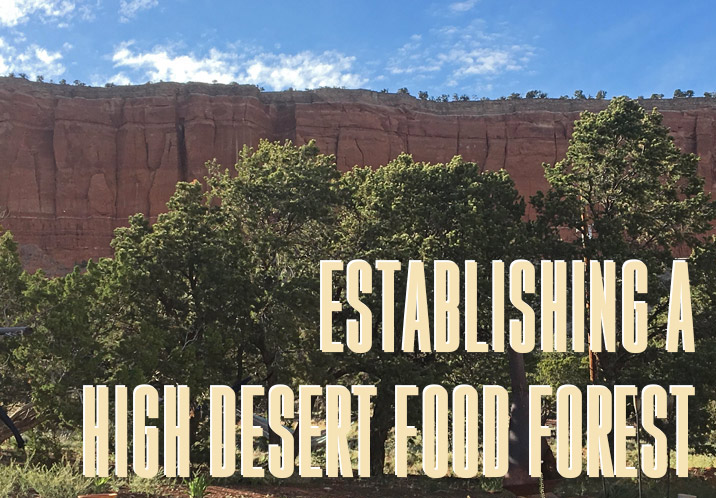
3 comments
thanks for this info, a lot of it may also apply to eastern WA state
Great article thanks!! I love the high western areas of the US, though I’ll probably move to basically the opposite like FL!
Also, I love the mixture of gardening and music. And your video on terra preys was very inspiring!
Thanks!
Well written and researched article, DtG!
I live and permaculturize in the very southern portion of New Mexico, south of the property in question. It’s hotter and drier here.
In four years of growing out multiple tree species from seed, trees that I will use for an upcoming food forest project, I found that black locust is extremely useful here.
It’s nearly the fastest growing of the trees I’ve been trialing. Mexican Palo Verde can grow a tad faster here, but I don’t think those will grow in Gina’s zone. Black locust has toxic bark- and in rabbit country, that is an amazing gift. It’s a fast grower, nitro fixer, the leaves are edible to animals- but not the bark (making it less likely to get ringed), it flowers abundantly, provides nectar, attracts loads of pollinators, plus it makes leaf and flower litter. So it’s a soil builder extraordinaire.
In my area it grows faster than honey locust and per New Mexico resources I’ve found , it requires about half the water of honey locust. On top of all that, black locust is used extensively in landscaping in the desert SW. I can collect all the seed I require from trees in parking lots!
Comments are closed.